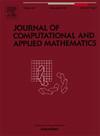Discrete biquaternion linear canonical transform
IF 2.6
2区 数学
Q1 MATHEMATICS, APPLIED
Journal of Computational and Applied Mathematics
Pub Date : 2025-08-09
DOI:10.1016/j.cam.2025.117010
引用次数: 0
Abstract
The landscape of signal processing has witnessed significant advancements over the years, driven by the need for efficient and accurate techniques to analyze and manipulate complex data. While traditional Fourier-based methods have been instrumental, they often struggle to capture the intricate nuances of signals that exhibit non-linearity, non-stationarity, or dual characteristics. To address these limitations, a novel approach namely the Discrete Biquaternion Linear Canonical Transform (DBiQLCT) is introduced in this paper. Because of the inherent non-commutativity of biquaternion algebra multiplication, the Discrete Biquaternion Linear Canonical Transform (DBiQLCT) has three unique forms: left-sided DBiQLCT, right-sided DBiQLCT, and two-sided DBiQLCT. We first introduce a notion of DBiQLCT and subsequently investigate the connections between these transformations. Following that, we investigate the two-sided discrete biquaternion linear canonical transform (TDBiQLCT), revealing important fundamental features such as linearity, time shift, conjugate, and modulation. We also establish the Plancherel and convolution theorems associated with the two-sided DBiQLCT. Furthermore, applications of the proposed transform are discussed at the end.
离散双四元数线性正则变换
多年来,由于需要高效准确的技术来分析和处理复杂数据,信号处理领域取得了重大进展。虽然传统的基于傅里叶的方法是有用的,但它们往往难以捕捉到表现出非线性、非平稳或双重特征的信号的复杂细微差别。为了解决这些限制,本文介绍了一种新的方法,即离散双四元数线性正则变换(DBiQLCT)。由于双四元数代数乘法固有的非交换性,离散双四元数线性正则变换(DBiQLCT)有三种独特的形式:左侧DBiQLCT、右侧DBiQLCT和两侧DBiQLCT。我们首先介绍DBiQLCT的概念,然后研究这些转换之间的联系。接下来,我们研究了双边离散双四元数线性正则变换(TDBiQLCT),揭示了重要的基本特征,如线性,时移,共轭和调制。我们还建立了与双侧DBiQLCT相关的Plancherel定理和卷积定理。最后,对所提出的变换的应用进行了讨论。
本文章由计算机程序翻译,如有差异,请以英文原文为准。
求助全文
约1分钟内获得全文
求助全文
来源期刊
CiteScore
5.40
自引率
4.20%
发文量
437
审稿时长
3.0 months
期刊介绍:
The Journal of Computational and Applied Mathematics publishes original papers of high scientific value in all areas of computational and applied mathematics. The main interest of the Journal is in papers that describe and analyze new computational techniques for solving scientific or engineering problems. Also the improved analysis, including the effectiveness and applicability, of existing methods and algorithms is of importance. The computational efficiency (e.g. the convergence, stability, accuracy, ...) should be proved and illustrated by nontrivial numerical examples. Papers describing only variants of existing methods, without adding significant new computational properties are not of interest.
The audience consists of: applied mathematicians, numerical analysts, computational scientists and engineers.

 求助内容:
求助内容: 应助结果提醒方式:
应助结果提醒方式:


